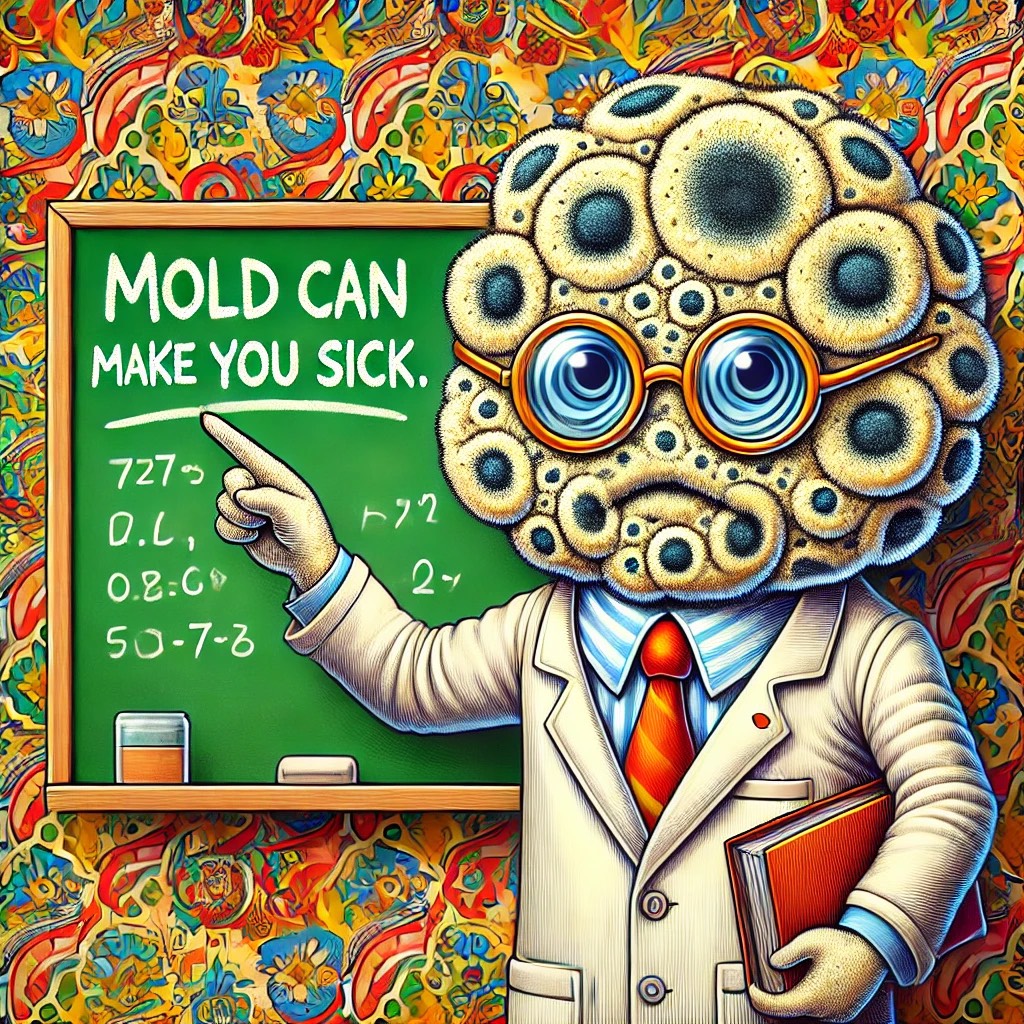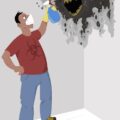Mold Hypersensitivity Syndrome Explained for Beginners
 Mold hypersensitivity syndrome has affected me, my daughter, and plenty of my clients. When I was attempting to recover from my chronic illness, I knew nothing about mold. Years later, when I had my daughter, I was forced to consider it after seeing her become disabled. Little did I know that investigating mold would be one of the best decisions I had ever made. Thankfully, after recognizing the severity of her mold sensitivity and making changes, she became symptom-free after six years of suffering.
Mold hypersensitivity syndrome has affected me, my daughter, and plenty of my clients. When I was attempting to recover from my chronic illness, I knew nothing about mold. Years later, when I had my daughter, I was forced to consider it after seeing her become disabled. Little did I know that investigating mold would be one of the best decisions I had ever made. Thankfully, after recognizing the severity of her mold sensitivity and making changes, she became symptom-free after six years of suffering.
In this article, I will discuss how mold hypersensitivity develops. In addition, I will talk about how it is often misdiagnosed and labeled as something that it isn’t. I will also cover my daughter’s story of mold hypersensitivity while providing tips to help you identify if mold is causing your symptoms. Lastly, I will address common questions about mold hypersensitivity syndrome. What are we waiting for? Let’s get started!
How Mold Hypersensitivity Syndrome Develops
Extended Time in Water-Damaged Building
After spending several months in a building full of toxic mold, your body will show you symptoms. The severity of these symptoms depends upon how compromised the individual’s immune system was before being exposed. In addition, it will depend on their history of mold exposure. If the person has a gut bacteria imbalance and has not been exposed to toxic mold, it may take months to show symptoms.
In contrast, if the person had been heavily exposed to that same mycotoxin in the past, it could take hours/days to see symptoms. Usually, the symptoms are far more severe when a sensitivity has developed. Trust me, I have not only experienced this myself, but I’ve seen it in my daughter and other clients.
Prior Immune Weakness Due to Gut Problems
Usually, people with mold sensitivities also have an imbalance in their gut microbiome. This instability in their gut sets them up for a hyperactive immune response. It also puts them at risk for a health-changing event like antibiotics, an infection, or a severe stressor. If your gut is a wreck, and you are consuming food you are sensitive to, then you are ripe for mold hypersensitivity syndrome. All you need is to live in a water-damaged billing for several months, and your immune system will be off to the races.
Antibiotic Use – COVID – Vaccines – Severe Stress
If your gut is compromised and you take a heavy-duty antibiotic while living in mold, you can become extremely hypersensitive. I have seen this happen to myself and many of my clients. After heavy-duty antibiotics, we suddenly started to present symptoms of mold sensitivity. It wasn’t like the mold grew while we took the antibiotics; our immune system became more sensitive to it. This is one of 1000 reasons I’m not fond of antibiotics.
To induce mold hypersensitivity syndrome, it has to be a significant immune-changing event. For example, getting COVID when your body is already compromised. Another example is getting a vaccine when your body is sensitive to one of its ingredients. Lastly, severe stress, like someone close to you dying or a relationship failing. Any one of these things can send your body over the edge when you already have a pre-existing immune issue.
Mold Hypersensitivity Symptoms Misdiagnosed
I went to countless doctors over 20 years, and only 1 mentioned the possibility of mold. Over that time, I struggled with various symptoms that were diagnosed as “fibromyalgia,” chronic fatigue syndrome, and plenty of other things. In the end, I learned that mold was causing a large amount of my symptoms. This made me realize that I was misdiagnosed by every doctor I met. With my daughter, it was the same story. The presence of mold caused her SEVERE symptoms, but after eliminating exposure, she became symptom-free.
I have not only experienced mold sensitivity myself, but I saw it in my daughter, and now I have a large client base of people recovering from mold illness. Ultimately, people get sick from what they consume, inhale, or think. If you ignore any of these areas, you risk a full recovery. Scroll down to learn more about my daughter’s mold hypersensitivity story. It’s about as extreme as it gets.
My Daughters Mold Hypersensitivity Story
When I got my daughter at 18 months old, she had a persistent cough and skin issues. I did not know what to do, so I tried various things without luck. We then moved into a house, and she started at a new school. Within months, all hell broke lose. Her eczema was so severe she was itching til she bled, wheezing/coughing after a minute of exercise, her eyes were crossing, her speech was slurring, she was convulsing in her sleep, having seizures, severe constipation, facial flushing, asthma attacks, and unable to remember simple things. It was a complete nightmare, and was probably the hardest time of my entire life.
Eventually, she got so bad that I had to pull her out of school. She was clearly reacting to something in the building now. I did not know what to do, so I started homeschooling her. She improved but still had plenty of struggles. Then, the biggest blessing of all came. We went on a vacation for 10 days, and she showed noticeable improvements. Though it wasn’t huge, some of her symptoms became less severe. We then returned home, and within hours she had a severe asthma attack. I finally realized something in the air was making her sick.
We then found a doctor to help perform mold testing on my daughter. She came back with elevated levels of trichothecenes in her urine, finally giving us an answer as to why she was so sick. Within six months of changing our environment and following the mold illness recovery protocol, she was symptom-free. It was a complete miracle! Without recognizing her mold hypersensitivity, I could have never created the proper strategy to get her better. To learn more about her story, click the link provided.
How to Know if it’s Mold Hypersensitivity Syndrome
When people are initially exposed to toxic mold, they have changes in their sinuses or breathing. These changes may be very minor, and also can be accompanied by dry eyes, tingling on the skin, and rashes. Over time, the person starts to have frequent infections like the flu, UTI’s, sinus infections, bronchial issues, and more. Often, people at this stage start to have skin issues as well. This can be dry patches of skin, eczema, blood pooling, white spots, and more.
Eventually, the body gives out and starts to have serious, debilitating flares. When the person reaches this stage, the immune system develops a sensitivity that can last for years after exposure has been eliminated. At this point, they are having strange reactions to smells, foods, stress, supplements, and nearly anything else in their environment. These reactions simply flare up the areas of the person’s body that are the weakest. This is why symptoms vary from person to person.
The worst part is, most doctors fail to identify mold as the cause of their issues. So, instead of alerting the person about their sensitivity, they label them with a disease and prescribe medication to try to mask their symptoms. This is why mold hypersensitivity is the number one cause of misdiagnosis in the chronic illness community.
FAQ- Mold Hypersensitivity Syndrome Mimics Various Conditions
Is mold hypersensitivity syndrome caused by limbic dysfunction?
Limbic system dysfunction is certainly a part of mold hypersensitivity, but it isn’t the cause. The cause of mold hypersensitivity syndrome is your own immune system. Unfortunately, it is so traumatized by the past exposure to the mold that it has created significant immune memory. Every time you are re-exposed, the mast cells secrete inflammatory molecules which trigger your symptoms. They then create antibodies and remember that mycotoxin even longer.
How long does mold hypersensitivity last after eliminating exposure?
If there is no exposure, studies suggest it lasts several months to several years. It depends upon the severity of the exposure and the age of the person when they were exposed. Even though it’s inconvenient to have this hypersensitivity, the truth is, you get used to living life cautiously. After a few years, it really isn’t a big deal anymore. Take it from me; I went through it with my daughter.
Will mycotoxin binders help to reduce symptoms of mold illness?
Mycotoxin binders can eliminate mold toxins from the body, but they won’t remove the hypersensitivity. This means your body may function better after using the binders, but certain mycotoxins would still trigger you. To beat the symptoms, you must eliminate exposure for an extended period, restore the gut, and recondition the limbic system.
Which lab tests can help me figure out if mold is an issue?
No tests confirm a hypersensitivity to mold. Despite this, there are tests that assess mycotoxin levels in your body and indoor mold tests that would confirm the presence of toxic mold. For more information on testing for mold illness, click the link provided. I review all the different testing methods in great detail.
Conclusion – Mold Hypersensitivity is a Hidden Epidemic
Right now, there are thousands of people out there thinking they have a chronic illness with no cure. The sad part is, many of them simply have undiagnosed mold hypersensitivity and are living in a toxic house. How do I know this? Well, I was one of them, and my daughter was too.
If you’re struggling with a chronic health issue, you must consider mold sensitivity as the cause. Whether it’s chronic migraines, digestive issues, chemical sensitivities, learning disabilities, eczema, or any other condition, mold can be implicated. As I said before, mold hits you where you are weakest. This is why it’s so difficult to identify unless you do proper mold testing or change your environment.
Are you struggling with mold hypersensitivity? If so, get in touch. I am willing to help and blessed to have the opportunity.
Happy healing everyone!
Matt Nedin
Certified Holistic Nutritionist
EndSickness, Founder
Phone: (734) 846-8619
Email: endsickness@gmail.com
WhatsApp/Telegram: +17348468619












